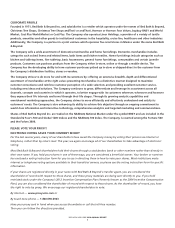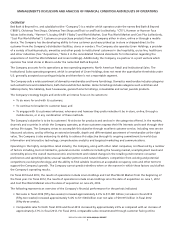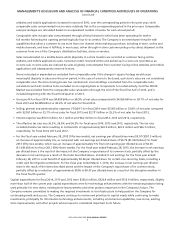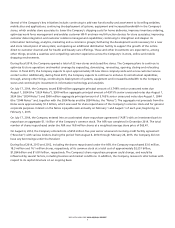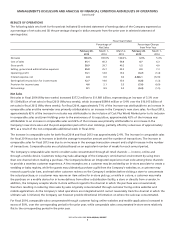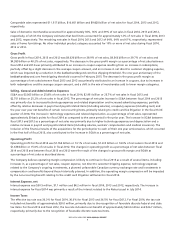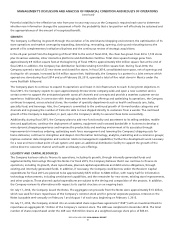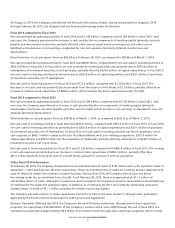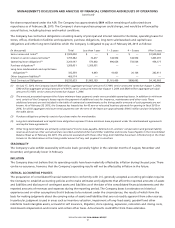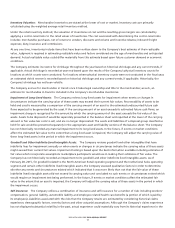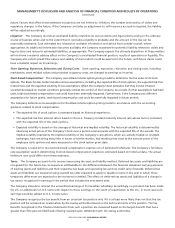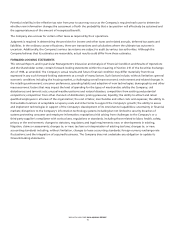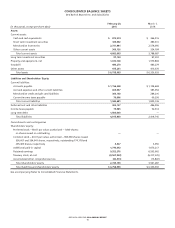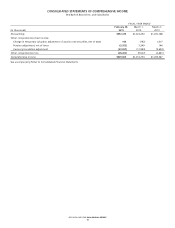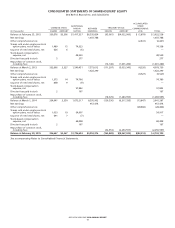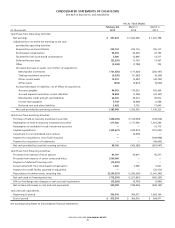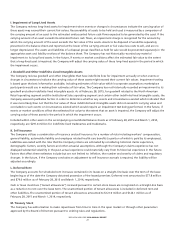Bed, Bath and Beyond 2014 Annual Report Download - page 16
Download and view the complete annual report
Please find page 16 of the 2014 Bed, Bath and Beyond annual report below. You can navigate through the pages in the report by either clicking on the pages listed below, or by using the keyword search tool below to find specific information within the annual report.future. Factors that affect these estimates include but are not limited to: inflation, the number and severity of claims and
regulatory changes. In the future, if the Company concludes an adjustment to self insurance accruals is required, the liability
will be adjusted accordingly.
Litigation: The Company records an estimated liability related to its various claims and legal actions arising in the ordinary
course of business when and to the extent that it concludes a liability is probable and the amount of the loss can be
reasonably estimated. Such estimated loss is based on available information and advice from outside counsel, where
appropriate. As additional information becomes available, the Company reassesses the potential liability related to claims and
legal actions and revises its estimated liabilities, as appropriate. The Company expects the ultimate disposition of these matters
will not have a material adverse effect on the Company’s consolidated financial position, results of operations or liquidity. The
Company also cannot predict the nature and validity of claims which could be asserted in the future, and future claims could
have a material impact on its earnings.
Store Opening, Expansion, Relocation and Closing Costs: Store opening, expansion, relocation and closing costs, including
markdowns, asset residual values and projected occupancy costs, are charged to earnings as incurred.
Stock-Based Compensation: The Company uses a Black-Scholes option-pricing model to determine the fair value of its stock
options. The Black-Scholes model includes various assumptions, including the expected life of stock options, the expected risk free
interest rate and the expected volatility. These assumptions reflect the Company’s best estimates, but they involve inherent
uncertainties based on market conditions generally outside the control of the Company. As a result, if other assumptions had been
used, total stock-based compensation cost could have been materially impacted. Furthermore, if the Company uses different
assumptions for future grants, stock-based compensation cost could be materially impacted in future periods.
The Company determines its assumptions for the Black-Scholes option-pricing model in accordance with the accounting
guidance related to stock compensation.
• The expected life of stock options is estimated based on historical experience.
• The expected risk free interest rate is based on the U.S. Treasury constant maturity interest rate whose term is consistent
with the expected life of the stock options.
• Expected volatility is based on the average of historical and implied volatility. The historical volatility is determined by
observing actual prices of the Company’s stock over a period commensurate with the expected life of the awards. The
implied volatility represents the implied volatility of the Company’s call options, which are actively traded on multiple
exchanges, had remaining maturities in excess of twelve months, had market prices close to the exercise prices of the
employee stock options and were measured on the stock option grant date.
The Company is required to record stock-based compensation expense net of estimated forfeitures. The Company’s forfeiture
rate assumption used in determining its stock-based compensation expense is estimated based on historical data. The actual
forfeiture rate could differ from these estimates.
Taxes: The Company accounts for its income taxes using the asset and liability method. Deferred tax assets and liabilities are
recognized for the future tax consequences attributable to the differences between the financial statement carrying amounts
of existing assets and liabilities and their respective tax bases and operating loss and tax credit carry-forwards. Deferred tax
assets and liabilities are measured using enacted tax rates expected to apply to taxable income in the year in which those
temporary differences are expected to be recovered or settled. The effect on deferred tax assets and liabilities of a change in
tax rates is recognized in earnings in the period that includes the enactment date.
The Company intends to reinvest the unremitted earnings of its Canadian subsidiary. Accordingly, no provision has been made
for U.S. or additional non-U.S. taxes with respect to these earnings. In the event of repatriation to the U.S., in most cases such
earnings would be subject to U.S. income taxes.
The Company recognizes the tax benefit from an uncertain tax position only if it is at least more likely than not that the tax
position will be sustained on examination by the taxing authorities based on the technical merits of the position. The tax
benefits recognized in the financial statements from such a position are measured based on the largest benefit that has a
greater than fifty percent likelihood of being realized upon settlement with the taxing authorities.
MANAGEMENT’S DISCUSSION AND ANALYSIS OF FINANCIAL CONDITION AND RESULTS OF OPERATIONS
(continued)
BED BATH & BEYOND 2014 ANNUAL REPORT
14


